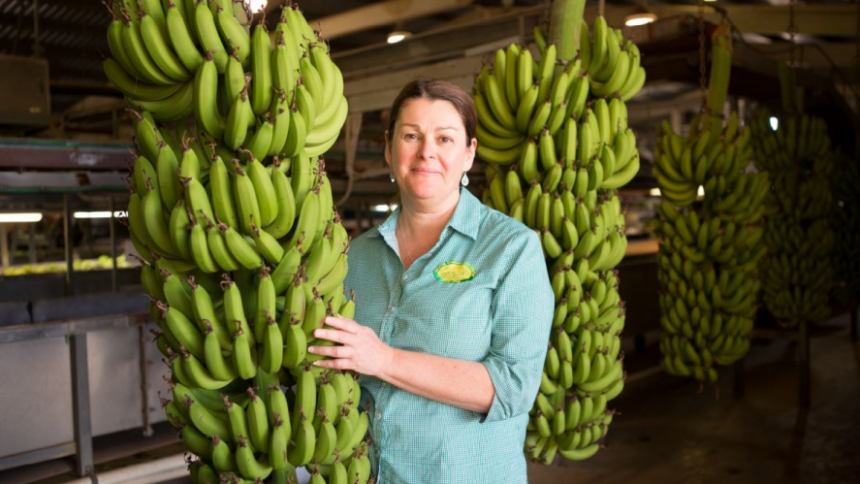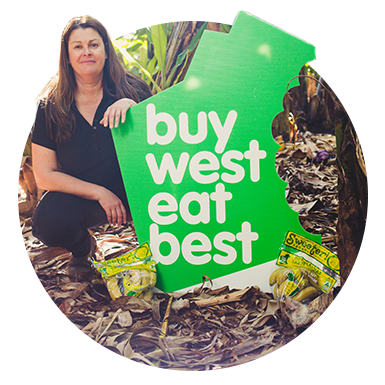
In the 1990s, Carnarvon banana growers were virtually giving away their fruit, receiving less than they cost to produce.
Up to 60 percent of the bananas grown were also being thrown away because retailers considered them “too small” compared with the better-known Queensland banana. Their thinner skin also made the local bananas more prone to marking and bruising when handled.
Faced with a number of obstacles, a group of Carnarvon growers banded together to form the Sweeter Banana Co-operative in 1993, determined to find a way to differentiate their produce and ensure it still looked good on arrival in stores.
“We realised that the smaller size of our sub-tropical banana not only results in great taste benefits but is the perfect size for kids to snack on, is easier for them to peel due to the thinner skin and fits perfectly into lunch boxes without bruising or cutting – giving us our unique brand and positioning,” Doriana recalls.
“We packaged the bananas into lunchbox banana-branded bags to help protect them from marking and distinguish the product in store from the tropical bananas.”
The innovation was a huge success, not just in terms of raising awareness of the quality of Carnarvon bananas but cutting back on waste.
“We now package 98 percent of our bananas into the bags for protection, and our waste has reduced by 50 percent to less than 5 percent.”
Sweeter Banana Cooperative members grow their produce on family-run farms and operate a central packing shed that packs and markets the bananas on behalf of everyone.
And the name is not just a marketing ploy. The bananas really do taste sweeter.
“Carnarvon Sweeter Bananas take twice as long to grow as tropical bananas. This makes them smaller and sweeter than the larger Queensland bananas and gives them a distinctive creamy banana flavour,” Doriana explains.
In a blind taste survey conducted by Curtin University, nine out of 10 people could taste the difference between the Sweeter Bananas and the faster growing Queensland bananas and eight out of the 10 preferred the local produce.
Doriana says that none of the growers use pesticides, fungicides or insecticides, either, opting to employ a healthy population of bugs to control pests and protect the environment.
Western Australian consumers are doing their bit for the environment when they buy local, too.
“Carnarvon Sweeter Bananas are shipped only within WA using less food miles and packed into re-useable crates instead of single-use cardboard cartons, so buying our product is great for the environment as well as your health,” Doriana says.
With Queensland dominating banana production in Australia, Doriana is passionate about informing Western Australians about the quality of their local bananas. It’s one of the reasons the co-operative got involved with Buy West Eat Best’s Good Choice campaign.
“It was really important for us to let WA consumers know that they could choose to buy a WA banana, not only for the qualities of the fruit itself but to help support our local industry,” she says. “The campaign was key in alerting shoppers that they do have a choice to buy local and educating local consumers about all the reasons to choose quality WA products when shopping for groceries.”
With the Sweeter Banana taking 18 months of careful nurturing to grow, the innovative farmers have come up with other ways to ensure their produce makes it to customers with minimal waste.
“We have developed a number of value-add products that can use fruit that has some skin markings from the growing process that make them less marketable as lunchbox bananas,” Doriana says.
“We make a delicious banana bread, which is available throughout Carnarvon and at the Manning and Kalamunda markets, and we also package ‘smoothie bananas,’ which are available in Coles.”
While working together ensured a future for the Gascoyne growers, they still faced some significant challenges, not the least of which was Cyclone Olwyn in 2015.
“It devastated our industry and we had no bananas at all for a 15-month period. When we re-entered the market in June 2016 it was a bit like starting again, getting WA consumers used to making our bananas their first choice.”
With typical fortitude, however, they were able to recover growing volumes, and credit Buy West Eat Best and the Good Choice campaign with helping to get them back on their feet.
“It has been key to resurrecting our local industry after the cyclone and supporting the livelihoods of our 25 grower members,” Doriana says.
“Our ongoing membership of the program will help continue to educate consumers about the benefits of WA bananas and help our industry become even stronger for the future.”
